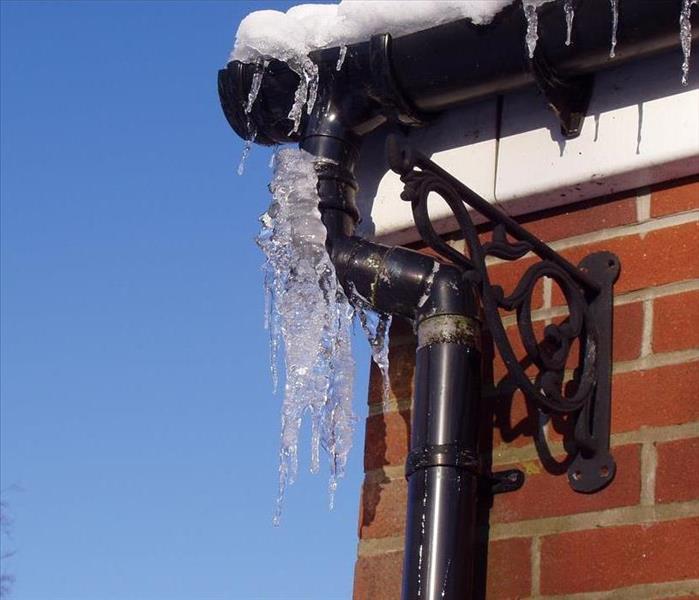Frozen Pipes
2/11/2019 (Permalink)
Last week we experienced dangerously cold weather, more will be on the way, SERVPRO of Howell/Wall would like to keep you informed about the messy and possibly destructive issue of frozen pipes. This article provides information around how to prevent water pipes from freezing, how to thaw pipes should they freeze, and what to do if your pipes burst.
Why do pipes freeze?
Water expands as it freezes, this puts pressure on whatever is containing it, whether metal or plastic pipes. No matter the durability of the container, expanding water can cause pipes in your home to break. Pipes exposed to the severe cold, like outdoor hose bibs, water sprinkler lines, and water supplies pipes in unheated or unfinished areas such as basements, crawlspaces, attics, garages or kitchen cabinets. Pipes against exterior walls that have little or no insulation are at risk for freezing.
What can I do to prevent frozen pipes?
Before the cold sets in, you can attempt to prevent freezing by:
Drain water from swimming pool and water sprinkler supply lines. Be sure to follow your manufacturer’s or installers directions.
Remove, drain, and store hoses used outdoors. Close inside valves supplying outdoor hose bibs. Open outside hose bibs to let water drain. Keep the outside valve open so any water remaining in the pipe can expand without causing the pipe to break.
Check around for unheated supply lines. Check the basement, crawlspace, attic, garage, and under kitchen and bathroom cabinets. Both hot and cold pipes need to be insulated.
Consider installing products made to insulate pipes like a “pipe sleeve” or UL-listed “heat tape” or “heat cable” or similar materials on exposed water pipes. Even ¼’ of newspaper can provide significant protection in areas that usually do not have frequent or prolonged temperatures below freezing.
What can I do during cold weather?
Keep garage door closed if there are supply lines in the garage.
Open kitchen and bathroom cabinet doors to allow warmer are to circulate around pluming.
Let the cold water drip from the faucet served by exposed pipes. Running water through the pipe helps prevent pipes from freezing.
Keep the thermostat set to the same temperature both during the day and at night.
If you will be going away during cold weather, leave the heat on in your home, set to a temperature more than 55° F.
What can I do if I think my pipes have frozen?
If you turn on a faucet and only a trickle comes out, suspect a frozen pipe. Keep the faucet open. As you treat the frozen pipe and the frozen area begins to melt, water will begin to flow through the frozen area. Running water through the pipe will help melt ice in the pipe.
Apply heat to the section of pipe using an electric heating pad wrapped around the pipe, an electric hair dryer, a portable space heater (kept away from flammable materials), or by wrapping pipes with towels soaked in hot water. Do not use a blowtorch, kerosene or propane heater, charcoal stove, or other open flame device.
Apply heat until full water pressure is restored. If you are unable to locate the frozen area, if the frozen area is not accessible, or if you cannot thaw the pipe, call a licensed plumber.
Check all other faucets in your home to find out if you have additional frozen pipes. If one pipe freezes, others may freeze, too.
What if my pipes burst?
When your home is being threatened by water damage from a burst pipe or any type of water damage from flooding or leaks, SERVPRO of Howell / Wall has the expertise to prevent or mitigate the devastating effects water damage can have in order to help preserve and restore your property. We have the equipment and experience necessary to handle the most challenging water damage and removal situations and are available around-the-clock. We concentrate on safely drying, deodorizing and disinfecting the areas flooded or damaged by water. When fire and water take control of your life, we help you take it back.
Contact SERVPRO of Howell/Wall Regarding Your Water Damage Emergency (732) 577-1010
Source: http://www.redcross.org/prepare/disaster/winter-storm/preventing-thawing-frozen-pipes





 24/7 Emergency Service
24/7 Emergency Service
